Advice for Choosing and Using a Backup Generator
Get an overview of the main considerations—including generator type, fuel source, and electrical-connection options—so you can reliably supply your home with electricity when there's a power outage.
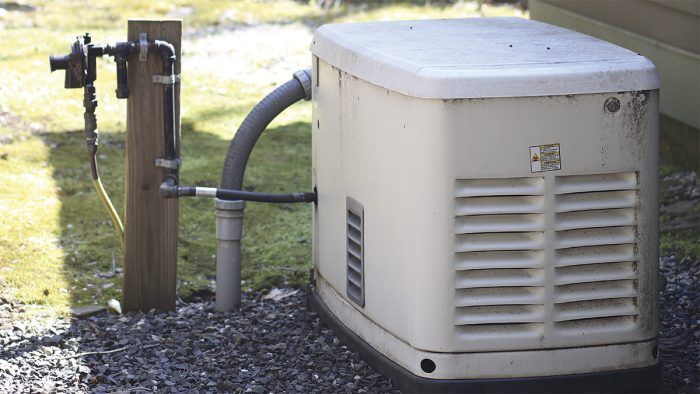
Senior editor Patrick McCombe describes his own experience researching, purchasing, and connecting a backup generator for his home, and he offers some insights into the choices and preparations you need to make in order for a generator to safely and reliably do everything you expect it to whenever you lose power to your home.
My family and I moved into our southwestern Connecticut home in 2010. It’s a cute little place, but it’s thirsty for electricity. Its drilled well has a 1-hp pump for domestic water. There’s an electric water heater and an electric range, and our furnace needs electricity for its blower and burner. When our power goes out, life gets difficult. Not only are we without heat and lights, but there is no water—hot or cold. Since moving here, we’ve had five prolonged outages ranging from four to 11 days. Fortunately, we only lost power once during the winter. That eight-day episode forced us to use a propane space heater to keep the pipes from freezing.
During the most recent outage, my wife, Carol, asked, “Can we please get a generator?” We’d had this discussion in past outages, but I resisted because of the noise, the expense, and the firm belief that if we ever bought a generator, we would never have a power outage again. Carol is a kind, patient woman not known for extravagances of any kind. Her pained look from days of flushing the toilet with a bucket of stream water, taking lukewarm sponge baths, and rummaging for soggy food in an ice chest showed there was only one answer to her question if I wanted to stay married.
There are two choices when it comes to generators: portables and standbys. Portable generators can be easier to set up; installing a standby generator is not something you can do quickly, even when a marriage is at risk. There are a bunch of steps and the process can take weeks or months, especially after widespread outages when the misery of being without power has people flooding dealers for installations. But portable generators have significant drawbacks as well.
Standby vs. portable generators
Portable generators are like those you see on construction sites. You put gas in them, start them up, and plug tools or appliances directly into their on-board outlets. Bigger models have wheels and handles so you can move them around; small ones you can carry like a suitcase. Instead of plugging directly into the generator, you can also connect a portable generator safely to your home’s electrical system with a transfer switch that prevents back-feeding power into the electrical grid, an electrocution hazard for line workers.
The downside to a portable generator is that you have to drag it out of the garage, connect it to the transfer switch, and get its small engine going before it can be of any help. That’s a big problem if the power goes out while you’re on vacation. You could come home to burst pipes or a freezer full of spoiled food. And because portable generators can go for long periods unused, another big problem is old gasoline. According to Jake Thomas of Generac, “People don’t use gas stabilizer. Gas goes bad after sitting for a month or two and when they need the generator, it won’t start.”
The alternative to a portable generator is a standby generator with an automatic transfer switch. A setup like this monitors utility power and when there’s an interruption, the generator starts and transfers selected circuits to generator power automatically. There’s a slight delay, usually 10 to 30 seconds, before the generator takes over—to get the engine running and to allow for very brief outages. When utility power is restored, the transfer switch goes back to utility power and the generator’s engine shuts off after a cooldown period. Another benefit of a standby generator is that they are quieter than large portables.
I debated for a few weeks about which type of generator to get, and then the pandemic hit. I suddenly felt like I couldn’t wait any longer. The prospect of being without power and having no place else to go to shower or wash clothes made me pull the trigger on a portable generator from an equipment dealer on Amazon. I bought a Yamaha EF7200 for just under $2000 and it was delivered a few days later.
Although large standby generators can be fueled by diesel, most residential units are powered by natural gas or liquid propane (LP). If you have natural gas service, connecting a standby generator to your home’s gas service seems like a no-brainer, but recent winter storms in Texas and other places unaccustomed to freezing conditions show that utility gas service can be interrupted by unusual conditions. You should also keep in mind that the most-visible specs on generator output found on product literature are based on using propane, which is more energy dense than gas. It’s common that models designed to be field-switchable from gas to propane will have less output when powered by natural gas.
If you don’t have gas, you’ll be running your generator on propane. Manufacturers have fuel requirements spelled out on their website, but commonly sized units from 10kw to 24kw use about 2 gal. of propane per hour at half-load. Thomas told me that most installers and propane dealers recommend at least a 250-gal. propane tank, which holds 200 gal. of propane, so you don’t run out during a days-long outage. If you use propane for your home’s heating system or other appliances, you’ll want to make sure your supplier fills the tanks before expected storms or you risk running out when the power is off.
My portable generator runs on gasoline. One of our past outages was a localized windstorm that knocked out the power for days. At the time, none of the gas stations around my house had power and therefore no gas. By the time I found an open station 15 miles from home, there was a line of cars filling gas cans. Though I didn’t have a generator at the time, that experience showed me that when you need a generator, you also need to have fuel on hand.
|
|
||
|
Ready for all weather
A standby generator is of no value if it doesn’t start when you need it. To keep things working, standby generators start themselves about once a week to exercise the engine and electrical components. You can choose how often it exercises and the day and time to minimize the disturbance from noise. Some models exercise at a slower-than-normal engine rpm to minimize noise.
Getting a generator’s small engine to start in cold weather can be a challenge, but running the heating system to prevent frozen pipes is one of the most common reasons to have a standby generator, especially in rural areas with less-reliable power. To make a standby generator’s engine easier to start, “Many have a block heater that sucks electricity to keep the engine warm in cold weather,” says Doug Horgan, vice president of best practices for BOWA in McLean, Va. “These things use a ton of electricity. The control system uses some power in standby too.”
David Duffield, director of sales for Champion’s standby generators, told me that his company uses a 24v starting system. The higher voltage allows the company to eliminate engine heaters, even in cold climates. If your system does have a heater, make sure its thermostat is working, so the system shuts off when you don’t need it.
This concern can be alleviated with a portable—my generator stays warm in my workshop, which is a conditioned space. I don’t like storing gas engines inside, even in a garage or outbuilding, but leaving them outside is worse. Not only will it be hard to start in winter, but mice and other critters like nesting in the cozy cavities found in power equipment. Their gnawing and urine can also cause damage and keep the generator from working when you need it.
Load management prioritizes power
Although you can get a generator big enough to power everything in the house at once, it will be costly and you’ll seldom, if ever, need its maximum output. A far more cost-effective strategy is to get a smaller generator and rely on some form of load management, the industry term for switching circuits on and off so the generator isn’t overloaded. Load management can be manual, meaning you have to physically turn on and off circuits, like turning off your central air conditioning or water heater while you’re using the oven.
More sophisticated systems manage loads automatically, turning off high-draw loads when more critical circuits call for power. Also described as load-shedding, a common example is turning off the central air conditioning when the water heater or well pump calls for power. After about 30 minutes, the transfer switch will try turning the air conditioning back on. If the water heater or other appliance is finished using electricity, the air conditioning will kick back in. If not, the switch will try again in another 30 minutes.
The most sophisticated transfer switches are current-sensing, meaning they shed and reconnect designated loads by monitoring their current draw and available power from the generator. Unlike timer-based controls, they can tell when the water heater has shut off and can turn the air conditioning back on without a wait.
The most high-tech systems allow you to change the settings in your load-management strategy from your smartphone. Becky Fellows, marketing manager for standby generators at Briggs & Stratton, said that these features are appreciated by second-home owners. “They can keep the home’s critical systems energized when they’re not there, but they can change priorities when they’re using the house,” she said. Everyone I spoke with agreed that advances in load management have made standby generators more useful and affordable.
My load-management strategy is pretty simple. My transfer switch has two 240v circuits: one for the well pump and another for the water heater. I can’t run them at the same time, so when I need hot water, I turn off the pump and turn on the water heater. During this period, we have to ration water. About 45 minutes later and I can turn on the pump again. I have to go to the basement to switch circuits.
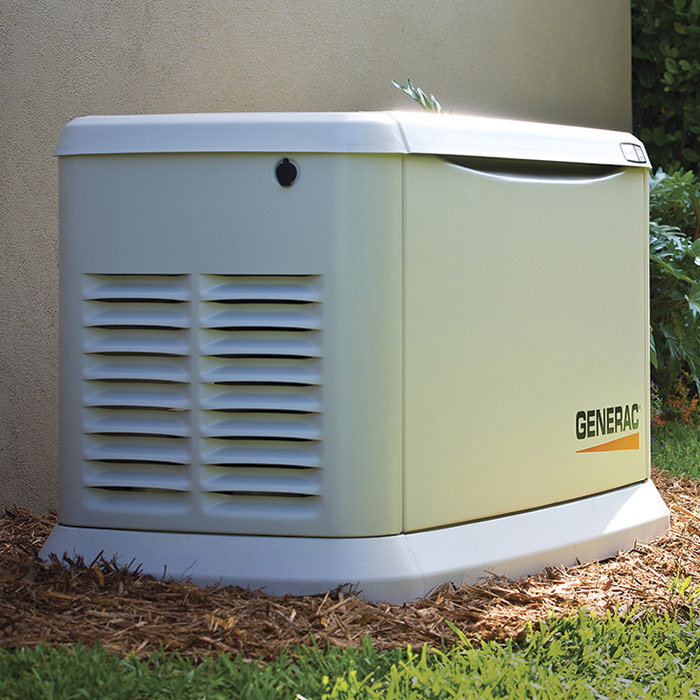 INSTALLATION CONSIDERATIONS — Fire-protection rules require standby generators be kept at least 5 ft. from any opening, including windows, doors, and exhaust and intake vents. They must also be installed on a sturdy composite or concrete pad above flood levels.
SIZING A STANDBYDetermining which model of generator to get depends on what you’re trying to power. Generator manufacturers have calculators on their websites to help size a generator and they are good for getting you in the ballpark, but a more reliable way is to have an electrician or a generator dealer figure out the exact loads with an ammeter and by checking motor and appliance rating plates. Resistance elements for cooking, heating, and domestic hot water use a lot of power, as do electric motors for HVAC equipment and pumps. When you add up the wattage required, you may decide that not everything on your generator wish list will make it, because bigger generators cost more to buy and run than smaller ones. Even models described as “whole-house” generally can’t power everything at the same time, so you need to figure out the critical circuits, add up all their wattage, and then select a generator that can deliver what’s required. Prices start at $3000 for the smallest models (7000w) and go up $30,000 or more for 125kw. Keep in mind that these prices are for the generator only. You’ll also need a transfer switch, wiring, fuel connections, and installation, which often doubles the final cost. I have to power a large well pump, which pulls between 4000w and 5000w at startup, combined with the furnace and a few receptacles and lights. For this reason I chose 7200w, which most people would consider a large portable.
|
Installation considerations
Even a small standby generator weighs several hundred pounds, so you need to consider how the installer will get it to where it needs to go. Fellows mentioned the concept of a “generator-friendly home” for new builds. Keeping the utilities close together or roughing-in pipes or cable to make the house generator-ready can significantly reduce installation costs. Part of my reasoning for a portable generator over a standby unit is that I don’t have natural gas service available and the house doesn’t currently have LP. Filling a propane tank and connecting a standby would cost at least $1000.
A generator installation is complicated. Skilled tradespeople and advanced do-it-yourselfers may have the skills necessary for an installation, but if problems arise, manufacturers can decline warranty coverage if the unit was installed by someone outside their dealer network.
Duffield said, “I would want an electrician who’s installed generators before, but if they haven’t, be sure the installation complies with the manufacturer’s instructions and NFPA 37”—the National Fire Prevention Association standard for permanently installed internal-combustion engines.
Properly sized standby units should be using about half the maximum wattage most of the time for the best balance of fuel efficiency and longevity. Units that are undersized can wear out prematurely from running at full capacity all the time.
By this point you must be wondering what I think about my portable generator purchase. In short, I made a big mistake. It is a complete hassle wheeling it into position and connecting it. I spent about $2500 on the generator and other components. Ironically, my house is small, and I have a basement—the ideal scenario for a standby unit. I’m told that I could have a similar-size standby professionally installed for between $5000 and $6000, and I wouldn’t have to deal with storing and buying gas. And unlike my portable, it would turn itself on when it’s needed, even when I’m not I’m there. It would also manage loads automatically, and in an outage, the family and I would be comfortably riding out a storm instead of dragging a 250-lb. generator through the yard.
Are batteries the future?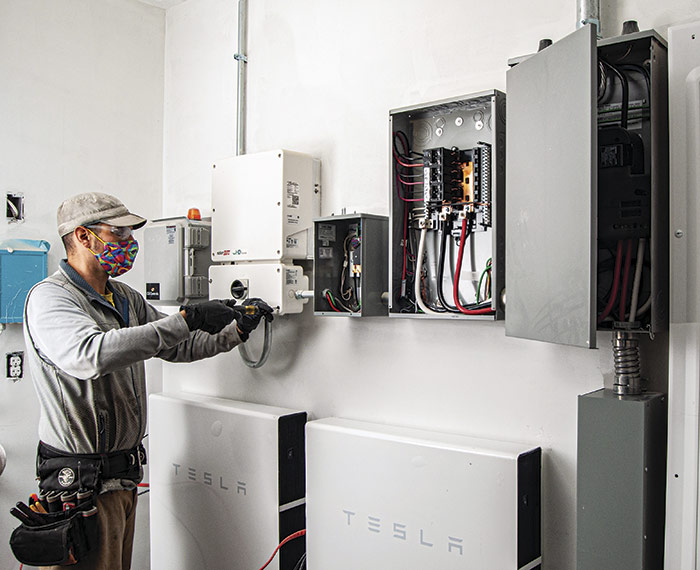 We’ve probably installed over fifty generators, from 5kw to 150kw. Most are 20kw to 40kw. If you want to see a client get mad, have a power outage when their generator won’t start. It’s often because it hasn’t been maintained, but I still get the call. We’ve also had trouble with sensitive electronics. One house with a gigantic whole-house generator is especially memorable: Sometimes at switchover, it freaked out the security and HVAC systems. The alarm wouldn’t stop sounding and all the thermostats turned themselves off. We also put in a bunch of generators with an English-made gas engine. They proved less reliable than a Jaguar. We’ve also put in big battery bank systems, similar to Tesla’s Powerwall. They’re reliable, they’re silent, and they work better with sensitive electronics. But big battery systems are expensive, and their power is limited. If you have batteries and PV panels, you may be able to ride out a prolonged outage. If you do run out of battery power, you can use a backup generator to recharge. I suspect we’ll see more big batteries soon. —Doug Horgan, VP of best practices for BOWA in McLean, Va. |
This article appears in Fine Homebuilding issue #300 titled “Power in a Pinch.”
Patrick McCombe is a senior editor.
Photos: courtesy of the manufacturers.
To view the entire article, please click the View PDF button below.

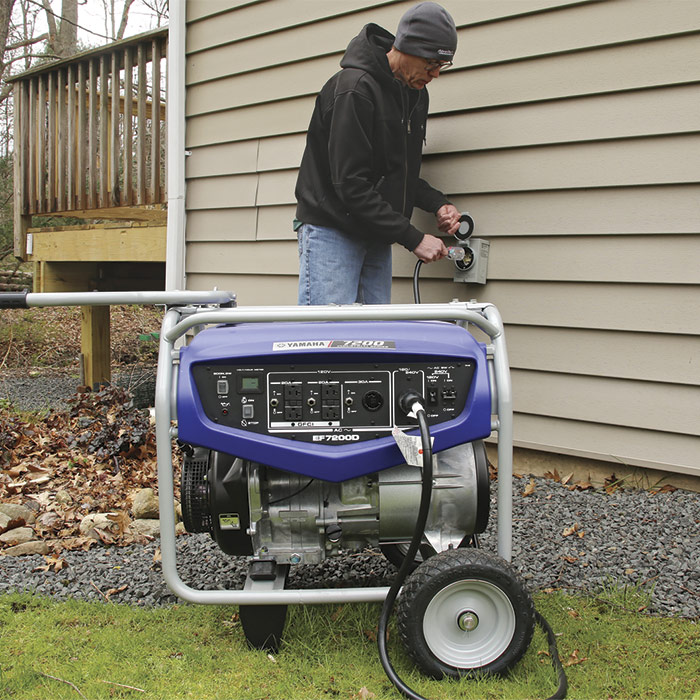
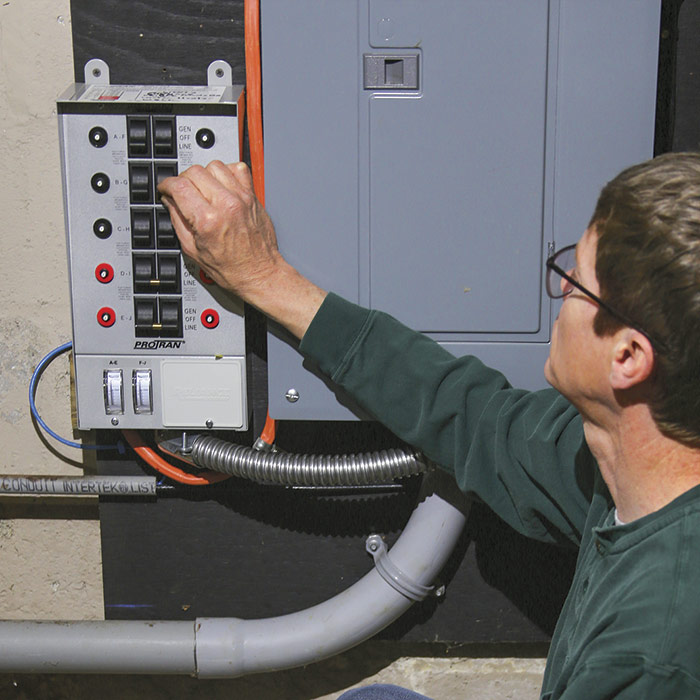
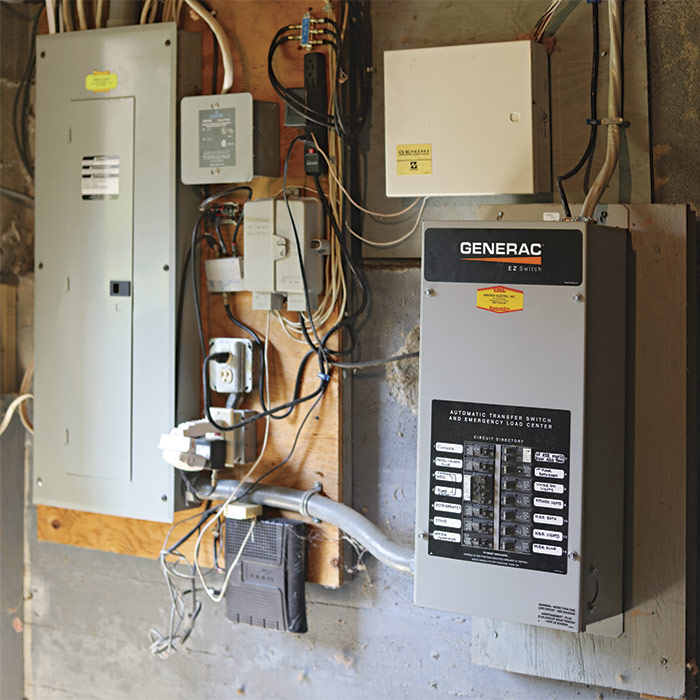

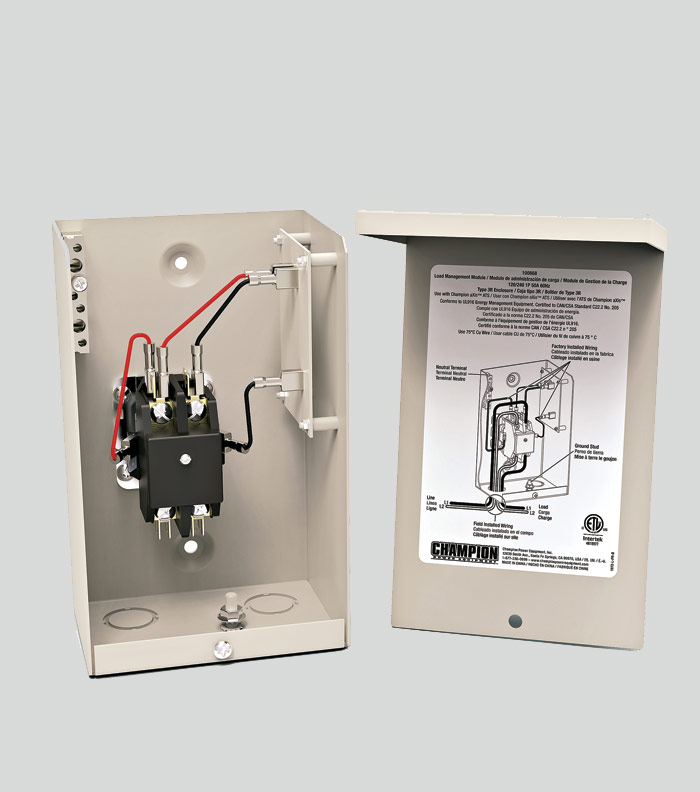
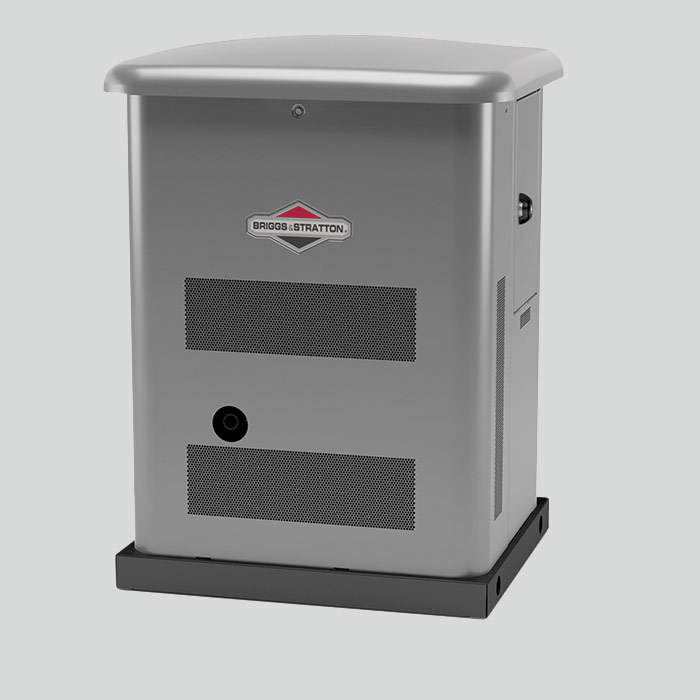
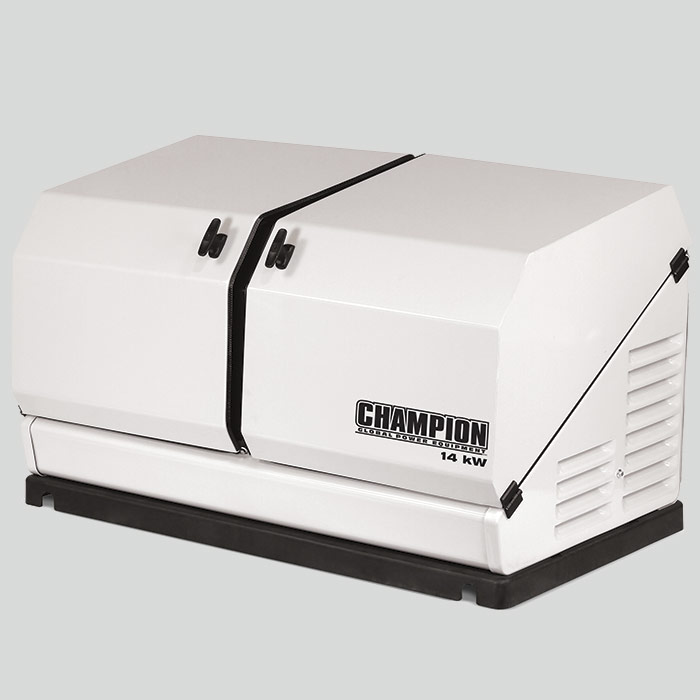


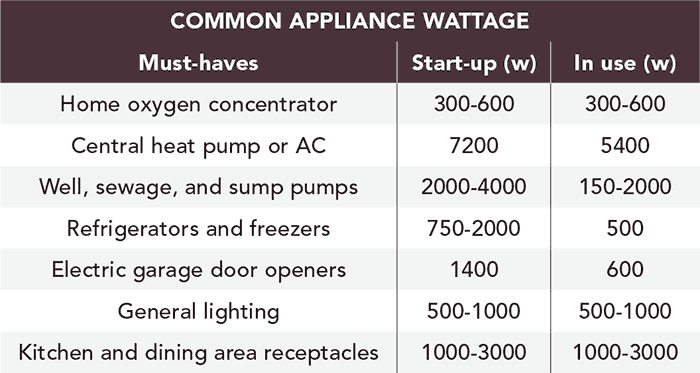
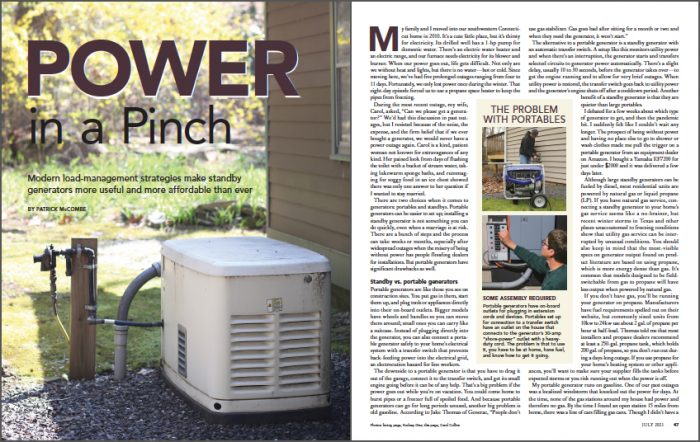





View Comments
We also use a portable gas powered generator and have a well. House is on a slab and there’s no natural gas in our neck of the woods. We manage with filling up the tub to flush toilets, having numerous safe drinking water for not only ourselves but the dogs. And our best investment was the solar powered portable generator that can charge our small electronics and the refrigerator. We charge it not only with the sun but the gas generator so both are always kept ready. We do need to get a transfer switch so we can plug in the gas generator and have fresh water. I think the neighbors might be upset since they also use the gas generator. But it would force them to finally get their own!
The article mentions problems with generators and appliances with "sensitive electronics." I think the problem is that the power from most generators isn't a nice clean sine wave but suffers from Harmonic Distortion, but that's as far as my knowledge goes. Anybody have better info?
While I see the many benefits to a standby, I chose to go with a portable. Dual fuel, gasoline and propane, electric start, fraction of the cost of a stand alone, and for me it is much more versatile, and useful far more often than for occasional power outages. I built a cheap little cart for it where it permanently resides, and I can haul it around my large property with lawn tractor or ATV to run power tools and air compressor (also on its own dedicated cart, think wagon train) anywhere an extension cord is not an option. Definitely the way to go for me.
I have decided to go with a smaller size dual fuel portable generator. I only need it as very occasional insurance since we rarely lose power but mostly want it to supply power for refrigerator, a few lights and (most importantly) natural gas boiler circulators so we can have heat in the winter. Propane fuel in 20 pound tanks can keep a long time without degradation and the smaller size generator will be quieter and easier to move. I will be using a generator interlock device that installs on the circuit breaker panel cover so that it will only allow generator power when main breaker is switched off. The beauty of it is that you can manually switch in whatever circuits you want to power (within limits of generator) instead of only certain hardwired circuits when using a traditional transfer switch panel.